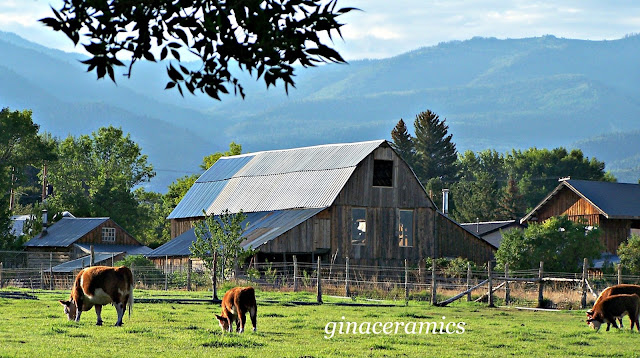Entirely dependent on each other.
Bees. It is estimated that in North America 30% of the food humans consume is produced from bee pollinated plants.
These beehives are located about a mile from our house.
The bees can see our house and they know that their first meal comes from the blossoms of our Box Elder Tree, very early in the Spring.
Our wild Apple Tree and Fruit Orchard provide the next meal. The value of bee pollination is about $16 billion in the United States alone.
Commercial pollination services will move as many as 60,000 bee colonies on flatbeds and leave them in fields for 2 to 3 weeks at a time. The bees are then moved to the next location.
When these vegetables start growing in our garden, our neighboring bees will make sure to come for a visit.
Cotton, Grapes, Sunflowers, Soybeans, Strawberries, Peanuts, Citrus, Alfalfa, Almonds, Annual and Perennial Flowers all need bees for pollination.
Cattle, sheep and many other animals feed on Alfalfa, making consumption of meat and dairy products possible. Honey production from about 135,000 American beekeepers totals more than 149 million pounds every year.
The old custom of moving beehives to crops where they are needed for pollination is observed in many countries. Here, beekeepers in Romania move from one field to the next, setting up housekeeping near their bees, often repeating the same route every year.
Bees in Romania
It's been an interesting week at our house. We had a bicycle club stop by for a catered Picnic a few days ago. They had been on a historic barn tour for three days.
Tomorrow a young boy will be baptized by his father in our Pond.
I am told that the entire entourage, dressed in white, will be coming down our lane singing songs from
"O Brother, Where Art Thou".
All the while, I have been painting ceramics for our Heritage Day Celebrations.
Many people came yesterday and a few dollars where left in our Valley and in my pockets.
Flowers are growing in my garden. Bees are visiting and so are our Friends from the big city.
Symbiosis, Yes.
I make sure that I have lots of flowers in my garden.
And in exchange, our Beekeeper provides us with the finest honey you will ever taste.
Have a wonderful week my dear friends.
Gina
Bees. It is estimated that in North America 30% of the food humans consume is produced from bee pollinated plants.
These beehives are located about a mile from our house.
The bees can see our house and they know that their first meal comes from the blossoms of our Box Elder Tree, very early in the Spring.
Our wild Apple Tree and Fruit Orchard provide the next meal. The value of bee pollination is about $16 billion in the United States alone.
Commercial pollination services will move as many as 60,000 bee colonies on flatbeds and leave them in fields for 2 to 3 weeks at a time. The bees are then moved to the next location.
Cotton, Grapes, Sunflowers, Soybeans, Strawberries, Peanuts, Citrus, Alfalfa, Almonds, Annual and Perennial Flowers all need bees for pollination.
The old custom of moving beehives to crops where they are needed for pollination is observed in many countries. Here, beekeepers in Romania move from one field to the next, setting up housekeeping near their bees, often repeating the same route every year.
Bees in Romania
It's been an interesting week at our house. We had a bicycle club stop by for a catered Picnic a few days ago. They had been on a historic barn tour for three days.
Tomorrow a young boy will be baptized by his father in our Pond.
I am told that the entire entourage, dressed in white, will be coming down our lane singing songs from
"O Brother, Where Art Thou".
All the while, I have been painting ceramics for our Heritage Day Celebrations.
Many people came yesterday and a few dollars where left in our Valley and in my pockets.
Flowers are growing in my garden. Bees are visiting and so are our Friends from the big city.
Symbiosis, Yes.
I make sure that I have lots of flowers in my garden.
And in exchange, our Beekeeper provides us with the finest honey you will ever taste.
Have a wonderful week my dear friends.
Gina

































Dear Gina.
ReplyDeleteWhat a gorgeous post. I love your honey bee tile and the jugs with the bees.. your pottery is stunning..
I have many bees here. In fact a little too close to the house sometimes. Only the other day , I found two sliding into a little slot in one of my wooden walls. There is someone who has an apiary over the hill from me.
_How exciting to have a baptism at your place..
Stunning post and very informative Gina.
pleased you had good sales.
Happy Monday to you Gina.
val xx
Dear Val, Where you have one or two bees going into your wooden walls you probably have many more. They usually don't bother people but for those who are allergic it can be pretty serious business.
DeleteWhen I took pictures of the beehive by the old abandoned farm, the bees became very agitated and I hightailed myself out of there. I have been stung several times but luckily it only ouched for a little while and then it was over. Happy week to you Val. I love your new blog header. xo, Gina
We neglect the bee at our peril.
ReplyDeleteI love all of your stories Gina - your success at the Heritage Day, the Cycling Club calling by, and the prospect of the entourage arriving at your pond, singing whilst all dressed in white.
I actually live in a small town that is a Bee Guardian Town.
We have signs at all the entrances to the town with the words World's First Bee Guardian Town and a big illustration of a bee.
Last but not least your garden and trees are looking absolutely beautiful.
Dear Rosemary, So wonderful to hear that you live in the World's First Bee Guardian Town. And you are providing so much diversity in your garden which is sure to make your bees very happy. Mr G stops for every bee when he is out cutting our property. We realize that without the work of the bee we would be in peril.
DeleteMy Bee ceramics always sell first. Utah is called the Beehive State. So, across the big water, we have a lot in common. Have a great week. ox, Gina
Dear Gina,
ReplyDeletemarvelous images emerge from your valley bathed in sunshine. The artist's hands and eyes are visible in the wonderful presentation of painted ceramics,flower bouquets and nature. Sometimes I feel like being right there. Greetings, Sieglinde
Dear Sieglinde, When it gets too hot in Texas why not come for a visit. Our nights are cool and days are sunny and warm with a refreshing breeze cooling the landscape. This is the perfect time to visit our part of the world. You are invited. ox, Gina
ReplyDeleteSuch a beautiful and thoughtful post, Gina. I love how you've weaved all the elements together, visually and figuratively! I had no idea about moving bees from field to field - but of course that is how it would have to be done.
ReplyDeleteSending you both wishes for a gorgeous spring week! xo
Dear Georgianna, Not all Beekeepers move their hives. Our Beekeeper keeps his bees in the same area. Probably because we have many fields nearby which need pollinating. Our Alfalfa fields are cut 3 times during the growing season. There is always enough food for bees.
DeleteHave a wonderful week dear friend. ox, Gina
Dear Gina,
ReplyDeleteCongratulations on a successful Heritage Day. It's always good to see your ceramics juxtaposed to your beautiful flowers — they do seem to go hand in hand.
I mentioned the value of consuming local honey just the other day on another blog, so bees and honey must be in our consciousness now, and rightfully so. I was saying what you probably already know, which is that by consuming local honey (where bees are visiting plants close to the customer) one's immune system gets strengthened. Just one more reason to love bees!
Thank you Mark. It was the perfect day. Sunshine and smiling faces everywhere.
DeleteKnock on wood but I think you're right about the connection between bees and strenghtening the immune system. I'm living proof. Have a great week. Gina
I so love this post. And although some in our family don't mind the bees, some are allergic.. so I have to keep flowering plants to a minimum and in the outer zones. So many interesting facts!! xo marlis
ReplyDeleteDear Mrlis, I understand about the allergies. I have been stung because I put my hands on plants without looking. Mostly, bees in my garden, are so busy being single minded that they don't bother us. Now, wasps are a totally different story.
DeleteBeautiful series!
ReplyDeleteHello Gunilla, So nice of you to visit and leave a comment. It is so appreciated.
Deletevery lovely pics! thanx for sharing with us :)
ReplyDeleteHello Tina, Thank you so much for your very nice comliment. And thank you also for your visit.
DeleteWow, Gina...I wish there was a "Like" button on here. I would click on it about a billion times!!! This is so cool!!! I knew you lived in the midst of an alfalfa field, but I never realized just gorgeous your surroundings are and how valuable to the ecosystem!!!! Your flowers are all so pretty, and you did a great job with the photography. Cool that you were able to make some $$$ vea the Heritage Day celebration! You create picture perfect works of art, so it's no wonder your craft would sell!
ReplyDeleteThose are really neat bee accessories. The bees on the nearby farm would be proud that their likeness has been so nicely captured! Thanks for that shot of the bee pollinators in Romania, too. That's super cool to see how they just have their wagon house out there in the middle of nowhere and their picnic table set up for meals. That must be quite the life! And bicycles for their transportation!!! That's pretty cool!
Dear Alycia, I am so honored and so pleased that you liked this post. We are very lucky in that we live in an area where we can enjoy a bit of extra space with nature quietly doing what nature does best.
DeleteSo many countries still have professional beekeepers who don't mind living a nomads life thereby playing a most important role in providing food for all of us.
Thank you for visiting my blog and I so appreciate your lovely comments.